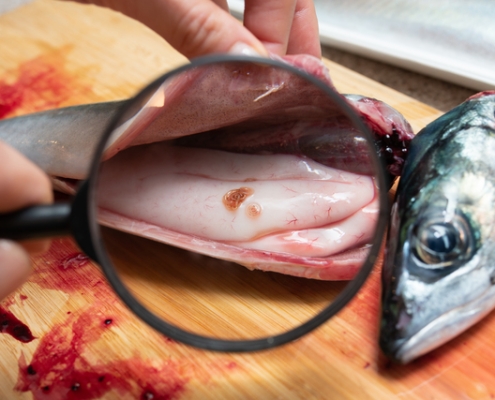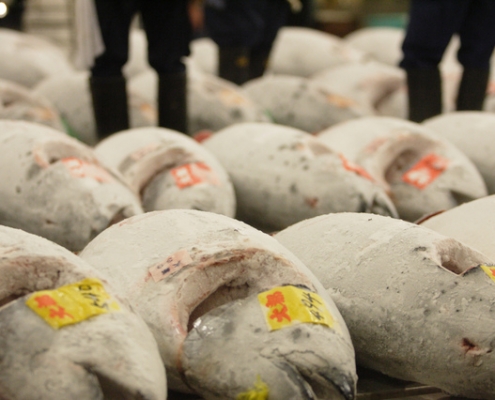Japanese Sushi Chefs VS Anisakis, Sushi Parasite
July 12 2022 Updated
The most well-known parasite hiding in sushi toppings is a worm called anisakis. For 200 years since the birth of sushi, Japanese sushi chefs have been making every effort to minimize the risk of this small parasite, while maximizing the umami flavor of the fish.
Contents
- 1 What Is Anisakis?
- 2 How to Kill Anisakis
- 3 What Kind of Fish Is Infected with Anisakis?
- 4 Is There a Difference between Wild-Caught and Farm-Raised Seafood?
- 5 Infection by Anisakis Increasing in Japan?
- 6 Can We Protect Japanese Food Culture with the Technique and Pride of the Sushi Chefs?
- 7 Innovation for Removing Anisakis
What Is Anisakis?
Anisakis lives in seafood, such as Saba mackerel, horse mackerel, bonito, herring, cod, sardine, salmon, trout, and squid. The white string-like worm is 2 to 3 cm in length and can be seen.
If you consume a fish that contains live anisakis, it may cause an allergic reaction in your stomach in around 8 hours and you can suffer a severe stomach pain.
Once a customer shows symptoms of the parasitic infection, the restaurant will be closed by the local public health center (known as “hokenjo”) and the reputation will be damaged as well.
For sushi chefs that deal with raw seafood, it is crucial to be aware of the risk of the infection caused by anisakis and to prepare ingredients in a manner that would reduce the risk.
How to Kill Anisakis
Anisakis does not die even if you marinate the ingredient in vinegar, salt it, or use soy sauce or wasabi. There are two recommended ways to kill anisakis.
Freeze at -20 ℃ for more than 24 hours
It is important that you freeze the ingredient at -20 ℃ or below AND for more than 24 hours.
If the temperature is higher or the period is shorter, it is possible that anisakis is not completely killed.
Cook
It is said anisakis dies instantly when cooked at 70 ℃ or above, or in a few seconds at 60 ℃.
Searing only the surface of the seafood will not kill the worms embedded in the meat, so you need to be careful.
What Kind of Fish Is Infected with Anisakis?
Saba mackerel, horse mackerel, bonito, herring, cod, sardine, trout, and squid are typical seafood in which anisakis is frequently found.
Shime-Saba Vinegarred Mackerel
Katsuo Bonito
In the Netherlands in the 1950s and 60s, many cases of anisakiasis were reported in those who ate green herring.
In Italy, a survey conducted on canned anchovies (Engraulis encrasicolus) showed that 2.3% of the product contained anisakis.
Anchovies
Since then, policies were established for the safety of the seafood. The EU requires all the seafood intended to be eaten raw be frozen at -35 ℃ for more than 15 hours or at -20 ℃ for more than 24 hours. In the United States, you need to freeze at -35 ℃ for more than 15 hours or at -20 ℃ for more than 7 days.
So, if your supplier follows these rules, anisakis is most likely killed in the process and the risk of the infection is not high.
Is There a Difference between Wild-Caught and Farm-Raised Seafood?
Since farm-raised fish eat food designed by humans, its risk of anisakis infection is considered low.
Popular sushi toppings, like tuna and salmon, are mostly farm-raised, but wild-caught ones can contain anisakis (as mentioned above, freezing the fish in accordance with the regulation will kill the parasites).
Infection by Anisakis Increasing in Japan?
On the other hand, a concerning report for sushi lovers was issued in Japan in June 2022.
According to the Ministry of Health, Labor and Welfare, the number of the cases of anisakiasis was 88 in 2013. Yet in 2022, the number amounted to 125 already by May.
If the pace keeps up, it is possible that there will be 300 cases by the end of the year.
This data drew the attention of those who work in the sushi business.
An expert explains the reason for the increase: “Adult anisakis lives in the stomachs of marine mammals, including whales and dolphins. The parasites’ eggs are released in the feces from these mammals and eaten by krill.
As the krill is eaten by other sea creatures, the parasite’s life cycle goes on. Recently, there are more whales, which serve as the definitive hosts, and this change could be a reason why we see more anisakis.”
Another expert claims: “There had been many cases of anisakiasis, but they were not reported to the government. The rule changed in 2012 in Japan and doctors who see a patient that could be having anisakiasis must report the case to the local public health center within 24 hours.
This way, it is just that there are more cases the government knows.” So, we cannot be certain about the exact reason for the increasing number of the cases.
One thing that is different from other countries is that Japan has not established regulations for freezing seafood that is to be eaten raw, even though many people eat raw fish.
Can We Protect Japanese Food Culture with the Technique and Pride of the Sushi Chefs?
Sushi chefs abroad may be surprised, but Japan only recommends freezing seafood that is intended to be consumed raw as of 2022. It is not a mandatory process.
When you freeze seafood, its cells are ruptured and the flavor will be lost compared to the ingredients that have not been frozen. There is also a sense of threat that mandatory freezing may cause Japanese cuisine chefs to lose the traditional techniques of cooking raw seafood.
Finally, Japanese chefs have been removing anisakis by using their own eyes, so considering their achievement and commitment, the government only recommends freezing seafood.
Then, how have Japanese sushi chefs decreased the risk of anisakis?
Even before the technology of freezing was established, chefs used their wisdom and knowledge to invent ways of removing anisakis and preserving the flavor of raw seafood.
For example, we have “hosogiri” (thin slices) of squid sashimi. Since anisakis dies when nicked, making minute slices into squid is a reasonable method to eat it safely.
A key to removing anisakis is to obtain fresh seafood in the first place.
Then, prepare it immediately and remove the internal organs, since anisakis hides in these places that have a lot of moisture and once the host dies the worm goes deep into the meat.
Anisakis is 2 to 3 cm long and you can see its thread-like body. Thus, chefs can use their skill and time to carefully examine the fish and find the worms.
Of course, more restaurants are beginning to ensure the customer’s safety by freezing some sushi toppings that are more at risk, such as Saba mackerel, and then use the chef’s eyes to find the parasite.
Innovation for Removing Anisakis
As the conclusion of this article, we introduce a new groundbreaking measure against anisakis.
In June 2021, a seafood company called Japan Foods invented a mechanism that runs the electricity of 100 MW through a slice of fish for a split second and kills anisakis.
The technology has become a hot topic in the industry.
The mechanism runs 15,000 V electricity, almost like lightning, for 1/1,000,000 second. This kills 99.9% of anisakis.
The technology is still in an experimental phase and it is expected to be mass-produced after 2025.
People hope that if the device becomes widely available, there will be more opportunity to serve sashimi of the fish that tends to be often contaminated by anisakis, such as Pacific saury.
The battle between sushi chefs and anisakis may enter a new phase in 2025.
What would you like to know more?

Culinary Schools in Japan
Tokyo Sushi Academy
The first and the most popular sushi school in the world.
Japan Culinary Institute
Japanese culinary training including sushi, kaiseki, yakitori, wagashi and more.
Miyajima Ramen School
More than 1,000 graduates from over 50 countries.
International Ramen School
Ramen study program combined with OJT



























